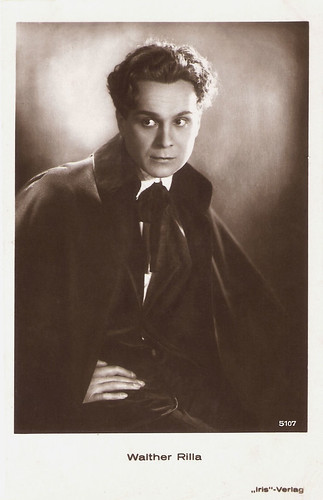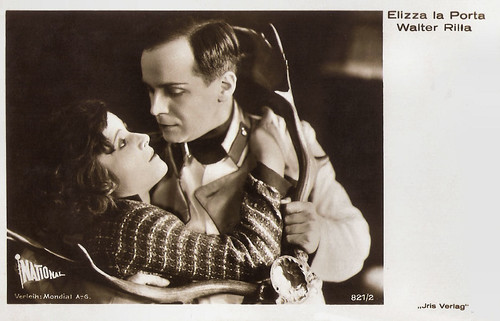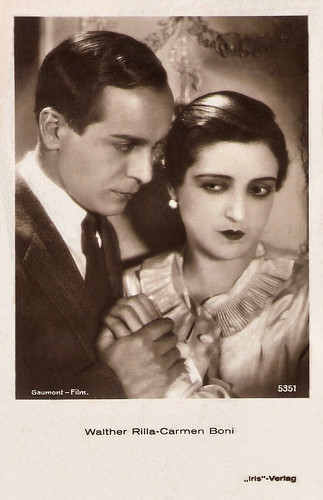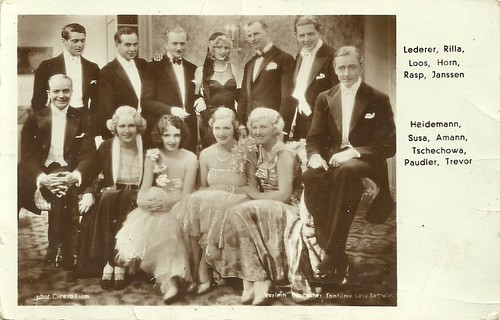German actor Walter Rilla (1894-1980) began his career in silent films and appeared in over 130 films between 1922 and 1977. In 1933 he took his family and fled the Nazi regime. In London, he played vile, foreign-tongued villains in spy films. He returned to Germany in the 1950s and wrote and directed for TV.

Austrian postcard by Iris Verlag, no. 673. Photo: Allianz-Film / Domo-Strauß-Film GmbH. Walter Rilla in the Austrian-German silent operetta film Hoheit tanzt Walzer/Her Highness Dances the Waltz (Fritz Freisler, 1926). The operetta film is based on the 1912 operetta 'Hoheit tanzt Walzer' by Leo Ascher (music) and Alfred Grünwald (libretto). The German distribution was taken care of by Domo-Strauß-Film. The film was a huge success, both critically and financially, and a major breakthrough for Rilla.

Austrian postcard by Iris Verlag, no. 821/1 Photo: National / Verleih Mondial A.G. Walter Rilla and Eliza La Porta in Die Sporck'schen Jäger/The Sporck Battalion (Holger-Madsen, 1927).

Austrian postcard by Iris-Verlag, no. 5012. Photo: Phoebus Film / Verleih: Philipp & Co. Maria Paudler and Walter Rilla in Die weiße Spinne/The White Spider (Carl Boese, 1927).

Austrian postcard by Iris-Verlag, no. 5107.

German postcard by Ross Verlag, Berlin, no. 5178/1, 1930-1931. Photo: Wengeroff-Film. Thanks to Walter Rilla expert Gerhild Krebs, we were able to identify the film. This card with Rilla as 'Apache' namely refers to the film Polizeispionin 77/Police Spy 77 (Willi Wolff, 1930). It was Rilla's second male lead in a film starring Ellen Richter, after Wie einst im Mai (Willi Wolff,1926). Polizeispionin 77 is considered a lost film.
Walter Rilla was born Walter Wilhelm Karl Ernst Rilla in Neunkirchen (near Saarbrücken), Germany, in 1894. He was the son of railway engineer Friedrich Wilhelm Rilla and his wife Caroline, née Gründer. He visited the Fridericianum school in Königsberg and the University of Königsberg. He studied literature, art history and philosophy in Königsberg, Breslau, Lausanne and Berlin.
He worked as a journalist for the Neuesten Breslauer Nachrichten (Latest Breslau News). In 1919 Rilla founded the literary journal Erde (Earth). At the time, he was involved with the Communist Party and, when established with the leftish KAPD party. From 1920 on, he worked as a story editor for the Berliner Theater.
Rilla made his film debut with a small role as the death angel in the Gerhart Hauptmann adaptation Hanneles Himmelfahrt/Hannele's Ascension (Urban Gad, 1922). Soon Rilla became one of the most important German character actors and worked with such other prominent directors as Victor Janson, Max Mack, and Reinhold Schünzel. In 1924 he appeared in one of F. W. Murnau's rare attempts at comedy, the hilarious Die Finanzen des Grossherzogs/The Finances of the Grand Duke (Friedrich Wilhelm Murnau, 1924) starring Alfred Abel.
A year later he starred opposite Jane Novak in the German-British coproduction Die Prinzessin und der Geiger/The Blackguard (Graham Cutts, 1925) written by the then 26-year-old Alfred Hitchcock. In 1926 Rilla starred opposite Elisabeth Bergner and Conrad Veidt in Der Geigenspieler von Florenz/Impetuous Youth (Paul Czinner, 1926), and two years later he costarred with Carmen Boni and Marlene Dietrich in Prinzessin Olala/Art of Love (Robert Land, 1928).
He made an easy transition into sound film. He played for example Baron Hans von Velten in Namensheirat/Marriage in Name Only (Heinz Paul, 1930), Robert in Männer um Lucie/Men Around Lucie (Alexander Korda, 1931) with Liane Haid, and Lord Windermere in Lady Windermeres Fächer/Lady Windermere's Fan (Heinz Hilpert, 1935).

Austrian postcard by Iris Verlag, no. 672. Photo: Allianz-Film / Domo-Strauß-Film GmbH. Walter Rilla and Claire Rommer in the Austrian-German silent operetta film Hoheit tanzt Walzer/Her Highness Dances the Waltz (Fritz Freisler, 1926).

Austrian postcard by Iris Verlag, no. 821/2. Photo: National / Verleih Mondial A.G. Eliza La Porta and Walter Rilla in Die Sporck'schen Jäger/The Sporck Battalion (Holger-Madsen, 1927).

Austrian postcard by Iris-Verlag, no. 5351. Photo: Gaumont-Film. With Carmen Boni.

German postcard by Ross Verlag, no. 1241/1, 1927-1928. Photo: Rischke & Marby.

German postcard by Ross Verlag, no. 1520/1, 1927-1928. Photo: Aafa.
In 1933 Walter Rilla moved with his family to London to escape the rising power of Adolph Hitler. His wife was Jewish and he refused to separate from her. He had no trouble establishing himself in British films after 1933. He started out in the hits The Scarlet Pimpernel (Harold Young, 1934) featuring Leslie Howard, and Abdul the Damned (Karl Grune, 1935) with Fritz Kortner.
Rilla only appeared in character parts, but he did work with respected directors like Robert Siodmak and Herbert Wilcox on successful British and French productions. He was seen for example as Prince Ernst in the Wilcox staged historical drama Victoria the Great (Herbert Wilcox, 1937) with Anna Neagle, and a year later, again in that role in the sequel, Sixty Glorious Years/Queen of Destiny (Herbert Wilcox, 1938). Other films were the adventure Hell's Cargo/Dangerous Cargo (Harold Huth, 1939), and the romance Black Eyes/False Rapture (Herbert Brenon, 1939).
In 1940 he became a British citizen. During the war years Rilla specialized in sinister foreigners — and, of course, Nazis - in such war films as The Adventures of Tartu/Sabotage Agent (Harold S. Buquet, 1943) starring Robert Donat and Valerie Hobson, and Candlelight in Algeria (George King, 1944) starring James Mason.
Aside from acting, Walter Rilla worked in the UK as a producer and screenwriter, and as an author of radio plays for the BBC. He also published some novels. After the war, Rilla continued his evil film ways in a progression of appearances as sultans, megalomaniacs and corporate villains. Probably the most interesting of these films is the thriller Desperate Moment (Compton Bennett, 1953) starring Dirk Bogarde as a man who tries to clear himself of murder in post-war Germany. Rilla directed one film himself, Behold the Man! (1951).
In 1957 Walter Rilla returned to Germany. There he had his first role in the Thomas Mann adaptation Bekenntnisse des Hochstaplers Felix Krull/Confessions of Felix Krull (Kurt Hoffmann, 1957) alongside Horst Buchholz. He followed this hit with a role in an equally popular film, Scampolo (Alfred Weidenmann, 1958) starring Romy Schneider. He then played in the last Mario Lanza vehicle, For the First Time (Rudolph Maté, 1959).

Austrian postcard by Iris-Verlag, no. 5438. Photo: Manassé, Wien (Vienna).

German postcard by Ross Verlag, no. 1750/1, 1927-1928. Photo: Hanni Schwarz, Berlin.

German postcard by Ross Verlag, no. 3083/1, 1928-1929. Photo: Phoebus Film.

German postcard by Ross Verlag, no. 3083/2, 1928-1929. Photo: Atelier Wulson, Berlin.

German postcard by Ross Verlag, no. 3291/1, 1928-1929. Photo: Ufa.

German postcard by Ross Verlag, no. 3714/1, 1928-1929. Photo: Ufa.
Walter Rilla appeared in the Edgar Wallace film adaptations Der Fälscher von London/The Forger Of London (Harald Reinl, 1960) and Zimmer 13/Room 13 (Harald Reinl, 1964) with Karin Dor. He played Dr. Mabuse in Das Testament des Dr. Mabuse/The Terror of Doctor Mabuse (1962) opposite Gert Fröbe, and Dr. Mabuse and Scotland Yard jagt Dr. Mabuse/Dr. Mabuse vs. Scotland Yard (Paul May, 1963) opposite Peter van Eyck.
In addition, Rilla was a writer, screenwriter, producer, and director of several stage and TV productions, and he worked as a television actor. From 1957 on he had an engagement at the Kleine Komödie in München (Munich). In 1966 he was awarded the Filmband in Gold for his work in German cinema.
Later films include the Spaghetti Western I giorni dell'ira/Gunlaw (Tonino Valerii, 1967) starring Lee van Cleef and Giuliano Gemma, the cult thriller Der Teufel kam aus Akasava/The Devil Came from Akasava (Jesus Franco, 1971) with Fred Williams and Soledad Miranda, and the interesting surrealistic Horror film Malpertuis/The Legend of Doom House (Harry Kümel, 1971) with Mathieu Carrière and Orson Welles.
He made his last screen appearance in the Thomas Mann adaptation Unordnung und frühes Leid/Disorder and Early Torment (Frans Seitz, 1977) with Ruth Leuwerik and Martin Held.
Walter Rilla died in 1980 in Rosenheim, Germany. He had been married twice. First, he married Theresa Klausner, who died in 1948. They had a son, prominent British-based film screenwriter and director Wolf Rilla (1920-2005). Since 1959, Walter Rilla was married to the French writer Alix Degrelle-Hirth du Frênes.

German postcard by Ross Verlag, no. 5761/1, 1930-1931. Photo: Paramount.

Austrian postcard by Iris Verlag, no. 967. Photo: Mondial / National.

German postcard by Ross Verlag, no. 5371/1, 1930-1931. Photo: Deutsche Universal-Film. Maria Paudler and Walter Rilla in Die große Sehnsucht/The Great Desire (Steve Sekely, 1930).

German postcard. Photo: Cicero Film / Distribution Deutsche Tonfilme.
The 'fine fleur' of late silent German cinema stars, united for a photo for an early sound film company. Standing left to right: Francis/Franz Lederer, Walter Rilla, Theodor Loos, Camilla Horn, Fritz Rasp and Walter Janssen, Sitting left to right: Paul Heidemann, Charlotte Susa, Betty Amann, Olga Tschechowa, Maria Paudler and Jack Trevor. This was possibly a promotion postcard for the early sound comedy Die grosse Sehnsucht/The Great Longing (Stefan Szekely a.k.a. Steve Sekely, 1930), in which all acted, mostly as themselves - only Loos and Horn played characters. The plot was an excuse for 35 stars to debut in a talking picture.

German postcard by Ross Verlag, no. 6857/1, 1931-1932. Photo: Studio G.L. Manuel Frères, Paris.

German postcard by Ross Verlag, no. 8378/1, 1933-1934. Photo: Atelier Binder, Berlin. Publicity still for Der Springer von Pontresina/The Champion of Pontresina (Herbert Selpin, 1934).
Sources: Stephanie D’heil (Steffi-line), Hal Erickson (AllMovie), Wikipedia (German), and IMDb.

Austrian postcard by Iris Verlag, no. 673. Photo: Allianz-Film / Domo-Strauß-Film GmbH. Walter Rilla in the Austrian-German silent operetta film Hoheit tanzt Walzer/Her Highness Dances the Waltz (Fritz Freisler, 1926). The operetta film is based on the 1912 operetta 'Hoheit tanzt Walzer' by Leo Ascher (music) and Alfred Grünwald (libretto). The German distribution was taken care of by Domo-Strauß-Film. The film was a huge success, both critically and financially, and a major breakthrough for Rilla.

Austrian postcard by Iris Verlag, no. 821/1 Photo: National / Verleih Mondial A.G. Walter Rilla and Eliza La Porta in Die Sporck'schen Jäger/The Sporck Battalion (Holger-Madsen, 1927).

Austrian postcard by Iris-Verlag, no. 5012. Photo: Phoebus Film / Verleih: Philipp & Co. Maria Paudler and Walter Rilla in Die weiße Spinne/The White Spider (Carl Boese, 1927).

Austrian postcard by Iris-Verlag, no. 5107.

German postcard by Ross Verlag, Berlin, no. 5178/1, 1930-1931. Photo: Wengeroff-Film. Thanks to Walter Rilla expert Gerhild Krebs, we were able to identify the film. This card with Rilla as 'Apache' namely refers to the film Polizeispionin 77/Police Spy 77 (Willi Wolff, 1930). It was Rilla's second male lead in a film starring Ellen Richter, after Wie einst im Mai (Willi Wolff,1926). Polizeispionin 77 is considered a lost film.
One of the most important German character actors
Walter Rilla was born Walter Wilhelm Karl Ernst Rilla in Neunkirchen (near Saarbrücken), Germany, in 1894. He was the son of railway engineer Friedrich Wilhelm Rilla and his wife Caroline, née Gründer. He visited the Fridericianum school in Königsberg and the University of Königsberg. He studied literature, art history and philosophy in Königsberg, Breslau, Lausanne and Berlin.
He worked as a journalist for the Neuesten Breslauer Nachrichten (Latest Breslau News). In 1919 Rilla founded the literary journal Erde (Earth). At the time, he was involved with the Communist Party and, when established with the leftish KAPD party. From 1920 on, he worked as a story editor for the Berliner Theater.
Rilla made his film debut with a small role as the death angel in the Gerhart Hauptmann adaptation Hanneles Himmelfahrt/Hannele's Ascension (Urban Gad, 1922). Soon Rilla became one of the most important German character actors and worked with such other prominent directors as Victor Janson, Max Mack, and Reinhold Schünzel. In 1924 he appeared in one of F. W. Murnau's rare attempts at comedy, the hilarious Die Finanzen des Grossherzogs/The Finances of the Grand Duke (Friedrich Wilhelm Murnau, 1924) starring Alfred Abel.
A year later he starred opposite Jane Novak in the German-British coproduction Die Prinzessin und der Geiger/The Blackguard (Graham Cutts, 1925) written by the then 26-year-old Alfred Hitchcock. In 1926 Rilla starred opposite Elisabeth Bergner and Conrad Veidt in Der Geigenspieler von Florenz/Impetuous Youth (Paul Czinner, 1926), and two years later he costarred with Carmen Boni and Marlene Dietrich in Prinzessin Olala/Art of Love (Robert Land, 1928).
He made an easy transition into sound film. He played for example Baron Hans von Velten in Namensheirat/Marriage in Name Only (Heinz Paul, 1930), Robert in Männer um Lucie/Men Around Lucie (Alexander Korda, 1931) with Liane Haid, and Lord Windermere in Lady Windermeres Fächer/Lady Windermere's Fan (Heinz Hilpert, 1935).

Austrian postcard by Iris Verlag, no. 672. Photo: Allianz-Film / Domo-Strauß-Film GmbH. Walter Rilla and Claire Rommer in the Austrian-German silent operetta film Hoheit tanzt Walzer/Her Highness Dances the Waltz (Fritz Freisler, 1926).

Austrian postcard by Iris Verlag, no. 821/2. Photo: National / Verleih Mondial A.G. Eliza La Porta and Walter Rilla in Die Sporck'schen Jäger/The Sporck Battalion (Holger-Madsen, 1927).

Austrian postcard by Iris-Verlag, no. 5351. Photo: Gaumont-Film. With Carmen Boni.

German postcard by Ross Verlag, no. 1241/1, 1927-1928. Photo: Rischke & Marby.

German postcard by Ross Verlag, no. 1520/1, 1927-1928. Photo: Aafa.
Escaping the rising power of Hitler
In 1933 Walter Rilla moved with his family to London to escape the rising power of Adolph Hitler. His wife was Jewish and he refused to separate from her. He had no trouble establishing himself in British films after 1933. He started out in the hits The Scarlet Pimpernel (Harold Young, 1934) featuring Leslie Howard, and Abdul the Damned (Karl Grune, 1935) with Fritz Kortner.
Rilla only appeared in character parts, but he did work with respected directors like Robert Siodmak and Herbert Wilcox on successful British and French productions. He was seen for example as Prince Ernst in the Wilcox staged historical drama Victoria the Great (Herbert Wilcox, 1937) with Anna Neagle, and a year later, again in that role in the sequel, Sixty Glorious Years/Queen of Destiny (Herbert Wilcox, 1938). Other films were the adventure Hell's Cargo/Dangerous Cargo (Harold Huth, 1939), and the romance Black Eyes/False Rapture (Herbert Brenon, 1939).
In 1940 he became a British citizen. During the war years Rilla specialized in sinister foreigners — and, of course, Nazis - in such war films as The Adventures of Tartu/Sabotage Agent (Harold S. Buquet, 1943) starring Robert Donat and Valerie Hobson, and Candlelight in Algeria (George King, 1944) starring James Mason.
Aside from acting, Walter Rilla worked in the UK as a producer and screenwriter, and as an author of radio plays for the BBC. He also published some novels. After the war, Rilla continued his evil film ways in a progression of appearances as sultans, megalomaniacs and corporate villains. Probably the most interesting of these films is the thriller Desperate Moment (Compton Bennett, 1953) starring Dirk Bogarde as a man who tries to clear himself of murder in post-war Germany. Rilla directed one film himself, Behold the Man! (1951).
In 1957 Walter Rilla returned to Germany. There he had his first role in the Thomas Mann adaptation Bekenntnisse des Hochstaplers Felix Krull/Confessions of Felix Krull (Kurt Hoffmann, 1957) alongside Horst Buchholz. He followed this hit with a role in an equally popular film, Scampolo (Alfred Weidenmann, 1958) starring Romy Schneider. He then played in the last Mario Lanza vehicle, For the First Time (Rudolph Maté, 1959).

Austrian postcard by Iris-Verlag, no. 5438. Photo: Manassé, Wien (Vienna).

German postcard by Ross Verlag, no. 1750/1, 1927-1928. Photo: Hanni Schwarz, Berlin.

German postcard by Ross Verlag, no. 3083/1, 1928-1929. Photo: Phoebus Film.

German postcard by Ross Verlag, no. 3083/2, 1928-1929. Photo: Atelier Wulson, Berlin.

German postcard by Ross Verlag, no. 3291/1, 1928-1929. Photo: Ufa.

German postcard by Ross Verlag, no. 3714/1, 1928-1929. Photo: Ufa.
Back in Germany
Walter Rilla appeared in the Edgar Wallace film adaptations Der Fälscher von London/The Forger Of London (Harald Reinl, 1960) and Zimmer 13/Room 13 (Harald Reinl, 1964) with Karin Dor. He played Dr. Mabuse in Das Testament des Dr. Mabuse/The Terror of Doctor Mabuse (1962) opposite Gert Fröbe, and Dr. Mabuse and Scotland Yard jagt Dr. Mabuse/Dr. Mabuse vs. Scotland Yard (Paul May, 1963) opposite Peter van Eyck.
In addition, Rilla was a writer, screenwriter, producer, and director of several stage and TV productions, and he worked as a television actor. From 1957 on he had an engagement at the Kleine Komödie in München (Munich). In 1966 he was awarded the Filmband in Gold for his work in German cinema.
Later films include the Spaghetti Western I giorni dell'ira/Gunlaw (Tonino Valerii, 1967) starring Lee van Cleef and Giuliano Gemma, the cult thriller Der Teufel kam aus Akasava/The Devil Came from Akasava (Jesus Franco, 1971) with Fred Williams and Soledad Miranda, and the interesting surrealistic Horror film Malpertuis/The Legend of Doom House (Harry Kümel, 1971) with Mathieu Carrière and Orson Welles.
He made his last screen appearance in the Thomas Mann adaptation Unordnung und frühes Leid/Disorder and Early Torment (Frans Seitz, 1977) with Ruth Leuwerik and Martin Held.
Walter Rilla died in 1980 in Rosenheim, Germany. He had been married twice. First, he married Theresa Klausner, who died in 1948. They had a son, prominent British-based film screenwriter and director Wolf Rilla (1920-2005). Since 1959, Walter Rilla was married to the French writer Alix Degrelle-Hirth du Frênes.

German postcard by Ross Verlag, no. 5761/1, 1930-1931. Photo: Paramount.

Austrian postcard by Iris Verlag, no. 967. Photo: Mondial / National.

German postcard by Ross Verlag, no. 5371/1, 1930-1931. Photo: Deutsche Universal-Film. Maria Paudler and Walter Rilla in Die große Sehnsucht/The Great Desire (Steve Sekely, 1930).

German postcard. Photo: Cicero Film / Distribution Deutsche Tonfilme.
The 'fine fleur' of late silent German cinema stars, united for a photo for an early sound film company. Standing left to right: Francis/Franz Lederer, Walter Rilla, Theodor Loos, Camilla Horn, Fritz Rasp and Walter Janssen, Sitting left to right: Paul Heidemann, Charlotte Susa, Betty Amann, Olga Tschechowa, Maria Paudler and Jack Trevor. This was possibly a promotion postcard for the early sound comedy Die grosse Sehnsucht/The Great Longing (Stefan Szekely a.k.a. Steve Sekely, 1930), in which all acted, mostly as themselves - only Loos and Horn played characters. The plot was an excuse for 35 stars to debut in a talking picture.

German postcard by Ross Verlag, no. 6857/1, 1931-1932. Photo: Studio G.L. Manuel Frères, Paris.

German postcard by Ross Verlag, no. 8378/1, 1933-1934. Photo: Atelier Binder, Berlin. Publicity still for Der Springer von Pontresina/The Champion of Pontresina (Herbert Selpin, 1934).
Sources: Stephanie D’heil (Steffi-line), Hal Erickson (AllMovie), Wikipedia (German), and IMDb.
No comments:
Post a Comment